Although the year was heavily punctuated by the emergence of the Covid-19 pandemic and global lockdown measures, 2020 may well become recognised across the financial landscape as a watershed year for retail investing.
The arrival of Covid-19, coupled with the development of zero-commission brokerage platforms, created a cocktail of conditions that led to individuals gaining stimulus packages they needed to take their first steps into the world of investing. The free time that the pandemic gave prospective retail investors was all that was needed to begin the retail boom.
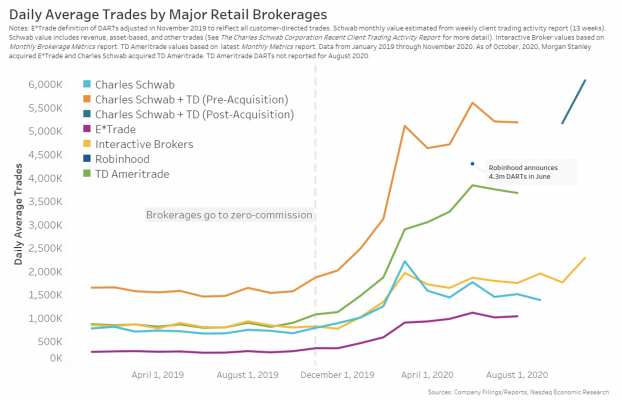
(Image: Nasdaq)
As we can see from the chart above, which relies on all the available data from retail brokerages, there is a clear upward trend in investment platform usage at the turn of 2020, paving the way for unprecedented levels of investment.
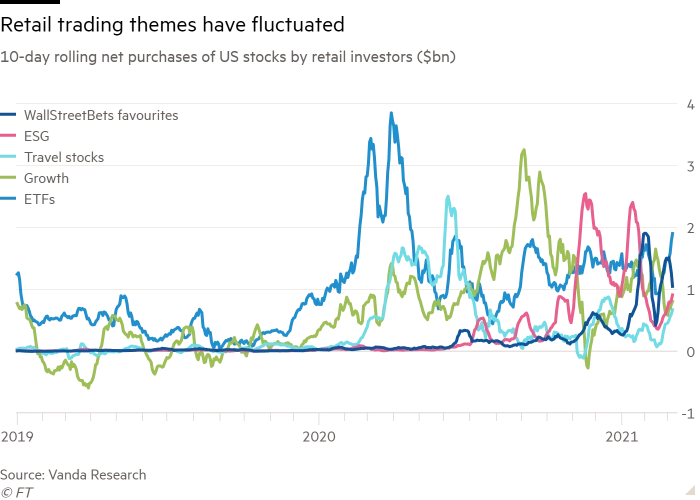
(Image: Financial Times)
However, despite new users flocking towards the world of retail investing in significant volumes, we can see that their investing habits have been chaotic to say the least. Since the emergence of Covid-19, we can see that retail investors have favoured ETFs, travel, growth, ESG and even meme-based stocks at times.
Naturally, new arrivals to the world of investing will need to find their feet and look to investments that they can learn to trust over time. But what options do retail investors have in this ecosystem? Let’s explore 12 options available for investors to consider storing their wealth:
1. High-Yield Savings Accounts
High-yield online savings accounts pay you interest on your cash balance. Just like a savings account earning pennies at your traditional bank, high-yield online savings accounts are easy-to-access stores for your wealth.
Equipped with fewer overhead costs, it can be easy to earn far greater interest rates at online banks. You’re also far more likely to be able to access the money you make quickly, with the ability to transfer it to your main bank account or through cash machine withdrawals.
With this in mind, a savings account is an ideal low-risk solution for individuals who would prefer to have the ability to access their cash at short notice in the near future.
High-yield savings accounts are great investments for investors who are largely risk-averse, and are particularly strong options for those who believe they may need to access their investment quickly. While some forms of investment, like bonds or real estate, are long-term investments where liquidity is locked, most savings account earnings can be transferred into bank accounts with little hassle.
Fundamentally, savings accounts are about as liquid as it’s possible to get in terms of investing. In many cases, it’s easy to add or remove funds at the drop of a hat – although you may find that your bank will limit the number of withdrawals you can make on a monthly basis.
Furthermore, the banks offering these accounts are typically insured by a domestic governing body – meaning that you’re extremely unlikely to lose your deposit. The largest risk attached to this sort of investment comes from your rates failing to adequately match up to the rate of inflation – meaning that you could be losing purchasing power rather than effectively saving your cash.
2. Mutual Funds
Mutual funds are a form of investment fund that’s operated by a money manager whose job is to invest money on your behalf in an attempt to attain better returns.
Mutual funds are typically made up of a combination of stocks and bonds, however, they can carry lower levels of risk because good money managers look to diversify your portfolio across a wide range of investments – meaning that if one industry faces a downturn, your money should be safely supported by your other investments. However, you’ll only be able to reap the benefits of your mutual funds from stock dividends and bond interest – or if you sell the value of your fund after a period of growth.
Because of their diversified nature, it’s highly unlikely that you’ll be able to retire through your mutual funds alone. This form of investment may be extremely safe, but it also misses out on the market volatility that can help shrewd investors to make big money in relatively short spaces of time.
When it comes to value for money, and growth potential, it’s important to note that your mutual funds are managed and built by experts, meaning that they’ll command a fee in return for what should hopefully be some high-quality financial insight.
How much does it cost to utilise the help of an expert? Professionals can expect a minimum annual compounded rate of return at 15% per year – or more in some cases. However, modern fintech apps and spare change saving platforms like Moneybox, Monzo and Starling all have functions where the company’s team of experts manage your investments automatically – at a risk level that you can choose – for far lower fees, albeit with potentially lower returns in the process.
Fundamentally, mutual funds can be an excellent investment for you if you’re unable to spend the time that you would like to strategize your investing on your own.
3. Exchange-Traded Funds
An exchange-traded fund, or ETF for short, is a form of security that tracks an index, sector, commodity or other asset, but which can be purchased or sold on a stock exchange in a similar manner to that of regular stock. ETFs can be structured to track just about anything from the price of an individual commodity to a far larger and more diverse range of securities. ETFs can also be created in a way that can track specific investment strategies.
One popular example of an ETF is the SPDR S&P 500 ETF (SPY), which simply tracks the S&P 500 Index. These ETFs can contain many investments, including stocks, commodities, bonds or a hybrid form of investment type. Exchange-traded funds are marketable securities, which means that it has a price attached to it which can easily be bought and sold.
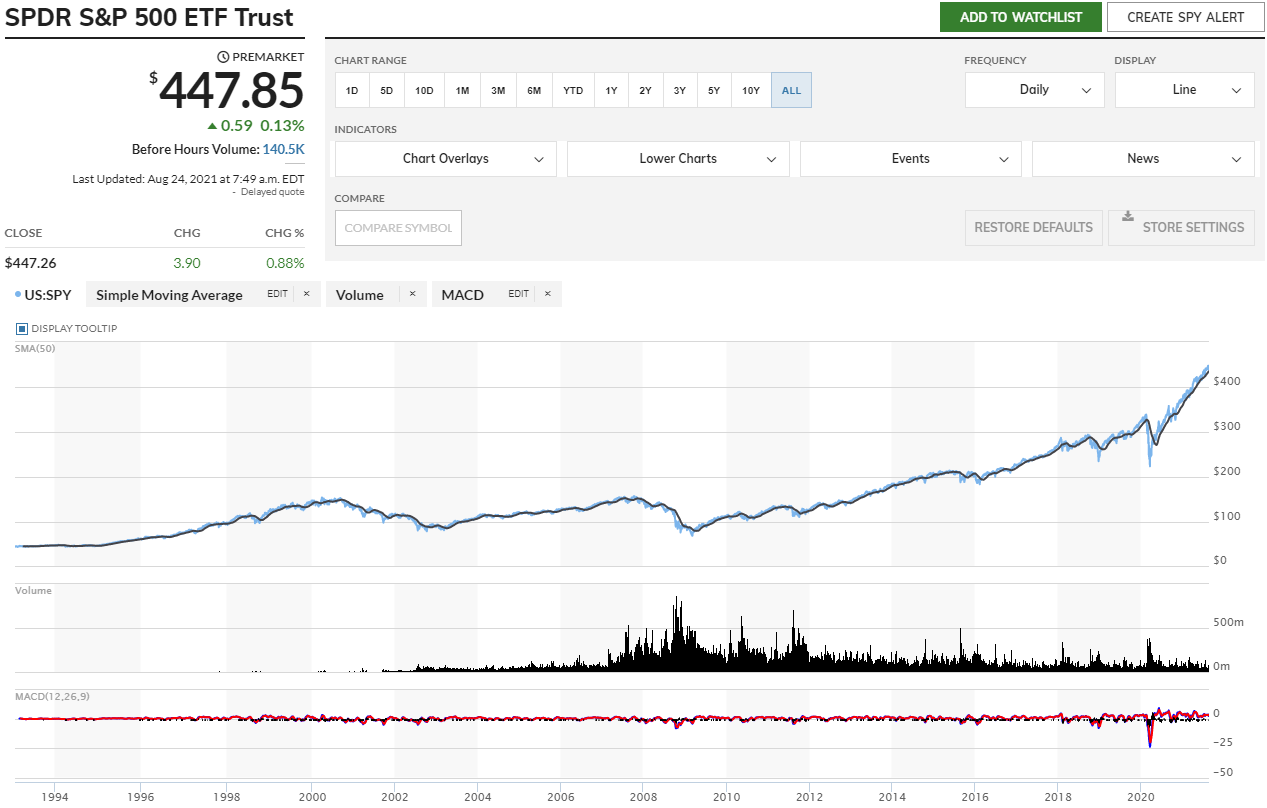
(Image: MarketWatch)
As we can see by checking out the aforementioned SPDR S&P 500 ETF, the value of investments made when the chart began in 1993 exchange-traded fund has returned over 1,000% in price appreciation in the space of 28 years.
ETFs can be particularly valuable as an investment option for newer investors because they’re naturally more diversified than individual stocks – meaning that it’s far easier to set up a more risk-averse portfolio by looking at exchange-traded funds. It’s also possible to further minimise the potential of risk by picking an ETF that tracks a broad index.
4. Certificates of Deposit
Certificates of deposit refer to federally insured savings accounts that offer a fixed rate of interest over a specific period of time.
This form of investment is best for saving money that you know you’ll need at a certain point in the future – like for a mortgage or a down payment for a wedding. The typical fixed-term rates can be between one, three and five years, so if you’re aiming to grow your savings for a specific reason and would like to access them in the not-too-distant future, a certificate of deposit could be the ideal approach for you.
However, it’s also important to note that to get your money out of a certificate of deposit early, you’ll probably be required to pay a fee – so it’s certainly not worth it if you’re aiming to buy a certificate of deposit with money that you may need to access sooner rather than later.
Certificates of deposit are generally sold based on their term length, and the best rates are typically found at online banks and credit unions. There are also many money comparison sites that are capable of displaying a range of CD options to help you figure out which is the best one for your needs.
5. Real Estate
Your investments don’t have to solely be stock and savings related. Real estate is considered to be one of the most enjoyable and lucrative asset classes to buy into today.
Real estate essentially refers to the land you purchase, along with any permanent improvements or structures attached to said land. These features can be either natural or manmade, and can include water, minerals, trees, buildings and bridges.
It’s also important to make the distinction between real estate and ‘real property’, which is sometimes referred to in place of ‘land’ or ‘real estate’ but the terms carry some notable differences that investors should be aware of.
While real estate refers to the land purchased in addition to any permanent manmade structures, the real property encompasses the interests, benefits, and rights inherent in the ownership of the real estate. Furthermore, the ownership of land refers directly to the earth’s surface downwards and upwards to the airspace above – including trees, minerals and water.
With this in mind, the term real estate includes the physical surface of the land, as well as everything below it and above it within the rights of ownership. These rights can include the right to possess, sell, lease and use the land – meaning that investing in real estate can offer a wide range of returns.

(Image: BBC)
Alternatively, as the data above shows, it’s also possible to simply own a property and see a handsome return on your investment. In the UK, house prices have accelerated away from the 2008 stock market crash to return year-on-year growth that’s far higher than the rate of inflation.
6. Options Trading
Options refer to contracts that you buy or sell at a set price, by a set date. Options can provide flexibility, as the contract doesn’t actually leave you obliged to buy or sell the stock. As the name indicates, this is purely an option. Most options contracts are created for 100 shares of a stock.
When buying an option, you’re essentially buying the contract rather than the stock it represents. You can then either buy or sell the stock at the agreed price within the specified time frame, sell the contract on to a different investor, or let the contract expire.
So, how can investors make money using options? Options trading can be rather complex for newcomers to the world of investing, but at a basic level, investors opt to lock in the price of a stock that they expect will increase in value. If this prediction is right, they will benefit by purchasing the stock for a far lower rate than market value. If they’re wrong, however, the purchase can be forgoed and the investor only loses the cost of the contract itself.
Options trading is an excellent way to make considerable profits from investing, but it’s also one of the riskiest options in our list. This is because to trade options successfully, you’ll either need a comprehensive market knowledge and understanding, or a significant amount of luck.
7. Stock Market Investing
Of course, no exploration into your investment options would be complete without looking at the potential of buying and selling stocks yourself.
Thanks to the rise of fintech investment apps like Freetrade in the UK and Robinhood in the US, many of which offer zero-commission payment-for-order-flow operating models which have been largely popular among retail investors, there has been a significant influx of investors looking to buy the stocks that they like the most – without feeling the urge to confer with financial experts or industry professionals.
Online brokerages enable investors to freely buy the stocks that they want – opening the door to ethical investing, or the ability to invest in specific industries that individuals are more knowledgeable of.
By investing in individual stocks and shares, investors can opt for more sustainable portfolios which can reward them for keeping their faith in green businesses, or invest in emerging technologies like virtual reality stocks.
However, it’s vital to note that individual investors looking to take it upon themselves to pick and choose their favourite stocks to buy into may be more liable to losing out more frequently than those who use ETFs or who buy into mutual funds. Despite this, if you firmly believe in an industry, or company, and would like to back up your support for them in a financial sense, it can be very rewarding to buy shares in a company on the stock market and watching your assets accumulate value.
8. Hedge Funds and Private Equity
Hedge funds and private equity are also valid investment options, although they certainly carry far more risk – this means that you’re required to be an accredited investor to participate. Accredited investors are people who have an annual income of over $200,000 and a personal net worth of $1,000,000.
Hedge funds are companies that attempt to aggressively achieve higher rates of return on their investments by utilising advanced strategies throughout global markets. Here, it’s worth noting that there’s a 2% management fee and 20% performance fee attached to managing your wealth through the help of a hedge fund.
There’s also no guarantee that you’ll see your returns appreciate – but greater risks comes with greater rewards, and hedge funds can help to generate significant returns on your investments. Private equity, on the other hand, is an asset class that consists of investments that aren’t publicly traded. Private equity firms invest in private companies and can find themselves involved in buyouts and company restructuring.
9. Dividend Stocks
Dividends are shares of a company’s profits that are given to shareholders and are generally paid out on a quarterly basis – acting like a bonus for investors. In this regard, they can enable shareholders to take an active role in the growth of a company that accounts for more than simple price accumulation.
Dividend stocks can either payout in cash dividends or stock dividends. Cash dividends act as a single sum that can arrive in the portfolio of an investor. If a company agrees to pay a dividend of 20p per share, somebody holding 100 shares would pocket £20, for instance.
On the other hand, stock dividends refer to percentage increases to the number of shares owned by the investor. If an investor owns 200 shares in a company that offers a 10% stock dividend, they’ll have 220 shares when the payout takes place.
However, there can be an element of risk attached to this method too. Companies that are underperforming and struggling to turn a profit will not only be unable to deliver on their dividend shares, but the overall value of the stock that you hold could fall.
10. Gold
Investing in gold and precious metals has been long identified as one of the most stable forms of investment possible. Gold has been around a long time and has played a significant role in the development of many economies. Although its influence in a practical sense is now somewhat more limited today, it’s still generally a reliable long-term investment.
Gold is particularly sought after by investors during periods of economic stagnation and downturn, due to the fact that the metal holds tangible value on a global scale.

(Image: Markets Insider)
As we can see from the chart above, gold as a commodity has climbed over 500% in value since the turn of the century, and its price notably gains traction during times of great instability – such as the stock market crash of 2008 and the Covid-19-driven crash of early 2020.
Although gold is a safe haven investment and a strong guard against inflation, we can see that it’s an asset that generally performs exceptionally well over time for investors who are after less risk in their portfolios.
11. Cryptocurrency
Cryptocurrency investments have been likened to ‘digital gold’, and although they’re highly technically advanced assets that can certainly be used as a safe haven store of wealth against underperforming stock market environments, investing in crypto like Bitcoin and Ethereum must be regarded as a wildly risky investment option.
However, as one of the fastest appreciating assets in the investing ecosystem, coins like Bitcoin do still deserve our attention.
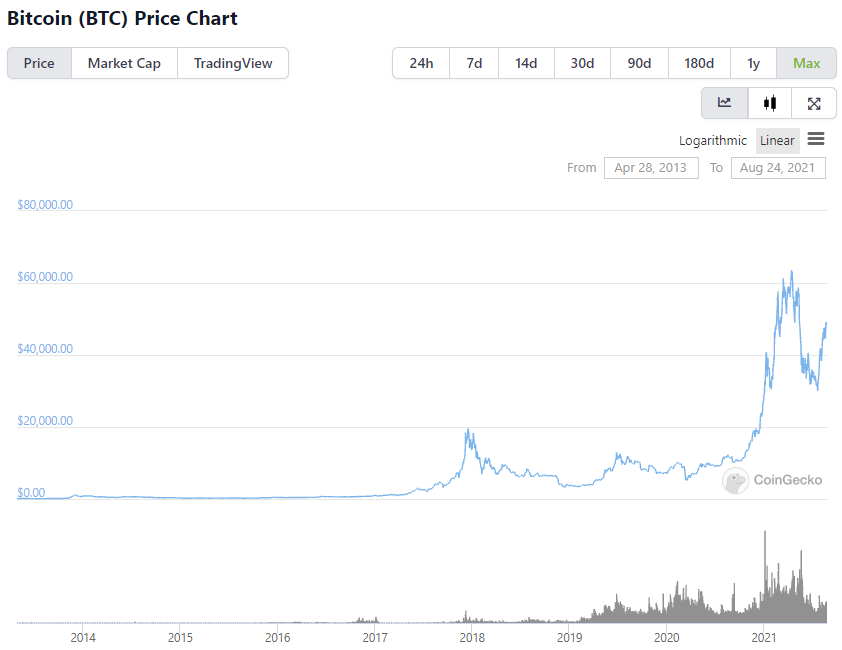
(Image: CoinGecko)
As we can see via Bitcoin’s historical price chart, the coin’s rise has been extraordinary. BTC’s lowest value since CoinGecko’s records began nestled at around $67.81 in 2013. Fast forward to 2021 and the cryptocurrency’s all-time high price weighed in at almost 100,000% of this figure at $64,804.72.
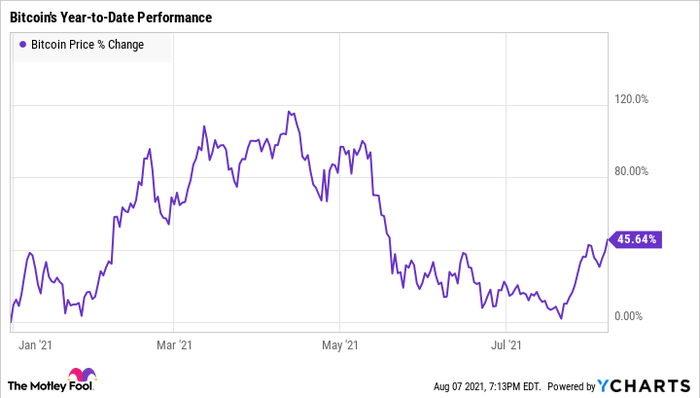
(Image: Nasdaq)
Bitcoin’s wild volatility is capable of delivering significant price rallies, but it’s also prone to causing heavy pullbacks. As we can see in the chart above, BTC’s year-on-year performance went from 120% to almost 0% between April and July of 2021.
The threat of further regulation from both the US and China could also derail Bitcoin’s huge growth, although with more institutional investment arriving in the form of Tesla and MicroStrategy, many of the cryptocurrency landscape’s most loyal followers claim that the best is yet to come.
12. Art
The issue with investing in stocks, options and ETFs is that you don’t have much to show for your money in the short term. However, it’s possible to buy artworks that are capable of holding your wealth or accumulating in value over time whilst returning an appealing visual installation for your home in the meantime.
In a not-too-dissimilar way to gold, art can make for a great store of wealth that can be better protected from downturns in domestic currencies and markets. However, unlike gold, there’s no guarantee that just because you’ve paid £2,000 for an original painting, someone else will be willing to pay the same amount.
Excitingly, the world of artworks has begun to merge in recent years with the world of cryptocurrencies in the form of NFTs. Standing for non-fungible tokens, NFTs are digital artworks that come with blockchain smart contracts that confirm ownership – and it means that investors can hold their wealth in a digital image before selling on should popularity pick up.
While the highest-selling NFT stands at $69 million, the collectible nature of NFTs has seen artworks as part of a far larger collection change hands for multi-million pounds a piece. This means that if you’re an investor who has an eye for emerging trends, NFTs can be particularly lucrative. However, it’s also certainly worth highlighting that many commentators believe that non-fungible tokens are encompassed in a bubble where such prices are unsustainable.
The world of investing can be full of opportunities regardless of your experience levels or personal wealth. Thanks to the development of fintech apps, we’re closer to our finances than ever, and there are plenty of places with varying levels of risk in which we can store our money for the future.
In this exploration of 12 options, we’ve considered some relatively low-risk and extremely high-risk investment opportunities, but it’s entirely up to you where you feel most comfortable with your money. Each investor has different goals and ambitions, and you will be no different. So take a moment to consider what you want to achieve from your investment, do your research, and then get out there and build your wealth.







![How Options Trading Works: The Ultimate Guide [2021]](https://daglar-cizmeci.com/wp-content/uploads/2020/12/Options-Trading-400x250.jpg)
